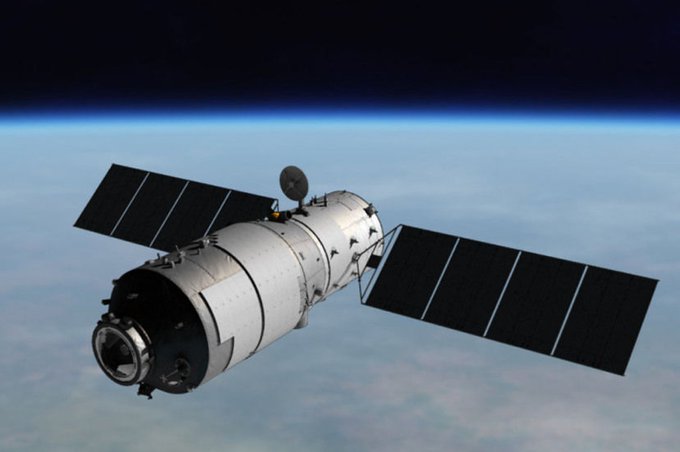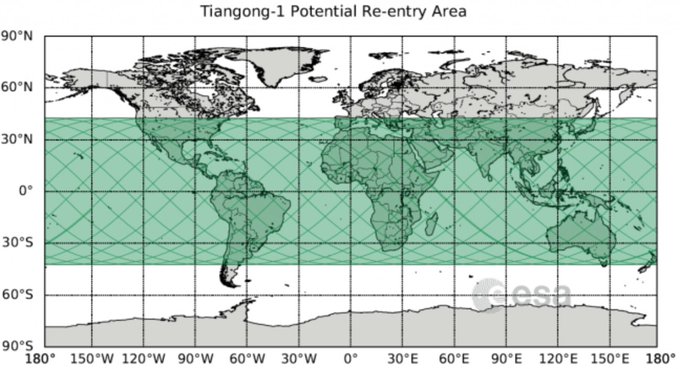- Joined
- Jul 10, 2008
- Messages
- 66,347
- Points
- 113
It's just one week until China's space lab crashes to Earth
25 Mar, 2018 12:27pm
3 minutes to read
By: Cleve Wootson, Amy B Wang
Or, in the words of fear-allaying scientists, Tiangong-1 was experiencing an "uncontrolled re-entry."
But semantics will do nothing to change the time of the increasingly likely disintegration date: April 1, or April Fools' Day, according to Business Insider. Although there is some wiggle room with that date, scientists have a pretty good sense of the drama that will unfold over the next few days.
Tiangong-1 is currently spinning around our atmosphere at a speed of about 28163km/h, taking one trip around the planet every 90 minutes. Although the air is thin in the zone where Earth's atmosphere ends and space begins, it's enough to slow the craft. As it loses its forward speed, gravity will begin to accelerate the craft toward Earth, and that's literally when the fireworks start.
"Have you ever skipped a stone on a lake?" Jesse Gossner, an orbital mechanics engineer who teaches at the US Air Force's Advanced Space Operations School, told Business Insider. "It bounces a few times, then eventually goes into the water."
The friction caused by thicker air will rip off anything sticking out of the side of Tiangong-1 - solar panels, antennae. That friction will also likely surround parts of the craft in superheated plasma (really, it's nothing to worry about, France).
But don't let that whole "superheated plasma thing" fool you. All might not be destroyed.
Related articles:
WORLD
Celebs march in protest against gun violence
25 Mar, 2018 8:52am
10 minutes to read
BUSINESS
Watchdog gets warrant to search Cambridge Analytica
25 Mar, 2018 8:10am
3 minutes to read
View image on Twitter

https://twitter.com/SPACEdotcom/status/976929962652389377
 SPACE.com
SPACE.com
✔@SPACEdotcom
China's Tiangong-1 Space Lab Expected to Fall to Earth Over Easter Weekend https://goo.gl/8m1ms4
10:13 AM - Mar 23, 2018
Twitter Ads info and privacy
The station is built like an onion, with layers upon layers of material. While the outside is glowing bright enough to be seen hundreds of kilometres away, some components nestled inside may be relatively safe.
Jonathan McDowell, an astrophysicist from Harvard University, told the Guardian that pieces weighing up to 100kg could make it to Earth's surface. According to the latest estimates, the parts of the lab that survive will crash into the ocean.
Still, scientists say, eagle-eyed observers will likely see it. According to the nonprofit research firm Aerospace, parts of the burning space station "may be visible and will likely last up to a minute or more, depending on time of day, visibility, conditions and the observer's location."
And even in the warned countries, there's an infinitesimal chance that falling debris will actually strike someone.
"In the history of spaceflight, no known person has ever been harmed by reentering space debris," the Aerospace said in January. "Only one person has ever been recorded as being hit by a piece of space debris, and, fortunately, she was not injured."
View image on Twitter

https://twitter.com/ChrisG_NSF/status/974700212605345792
25 Mar, 2018 12:27pm
3 minutes to read
By: Cleve Wootson, Amy B Wang
Or, in the words of fear-allaying scientists, Tiangong-1 was experiencing an "uncontrolled re-entry."
But semantics will do nothing to change the time of the increasingly likely disintegration date: April 1, or April Fools' Day, according to Business Insider. Although there is some wiggle room with that date, scientists have a pretty good sense of the drama that will unfold over the next few days.
Tiangong-1 is currently spinning around our atmosphere at a speed of about 28163km/h, taking one trip around the planet every 90 minutes. Although the air is thin in the zone where Earth's atmosphere ends and space begins, it's enough to slow the craft. As it loses its forward speed, gravity will begin to accelerate the craft toward Earth, and that's literally when the fireworks start.
"Have you ever skipped a stone on a lake?" Jesse Gossner, an orbital mechanics engineer who teaches at the US Air Force's Advanced Space Operations School, told Business Insider. "It bounces a few times, then eventually goes into the water."
The friction caused by thicker air will rip off anything sticking out of the side of Tiangong-1 - solar panels, antennae. That friction will also likely surround parts of the craft in superheated plasma (really, it's nothing to worry about, France).
But don't let that whole "superheated plasma thing" fool you. All might not be destroyed.
Related articles:
WORLD
Celebs march in protest against gun violence
25 Mar, 2018 8:52am
10 minutes to read
BUSINESS
Watchdog gets warrant to search Cambridge Analytica
25 Mar, 2018 8:10am
3 minutes to read
View image on Twitter

https://twitter.com/SPACEdotcom/status/976929962652389377
 SPACE.com
SPACE.com✔@SPACEdotcom
China's Tiangong-1 Space Lab Expected to Fall to Earth Over Easter Weekend https://goo.gl/8m1ms4
10:13 AM - Mar 23, 2018
Twitter Ads info and privacy
The station is built like an onion, with layers upon layers of material. While the outside is glowing bright enough to be seen hundreds of kilometres away, some components nestled inside may be relatively safe.
Jonathan McDowell, an astrophysicist from Harvard University, told the Guardian that pieces weighing up to 100kg could make it to Earth's surface. According to the latest estimates, the parts of the lab that survive will crash into the ocean.
Still, scientists say, eagle-eyed observers will likely see it. According to the nonprofit research firm Aerospace, parts of the burning space station "may be visible and will likely last up to a minute or more, depending on time of day, visibility, conditions and the observer's location."
And even in the warned countries, there's an infinitesimal chance that falling debris will actually strike someone.
"In the history of spaceflight, no known person has ever been harmed by reentering space debris," the Aerospace said in January. "Only one person has ever been recorded as being hit by a piece of space debris, and, fortunately, she was not injured."
View image on Twitter

https://twitter.com/ChrisG_NSF/status/974700212605345792
